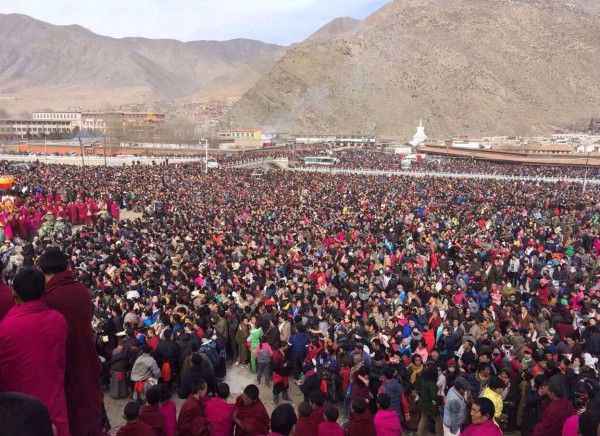- Last week, Tibetans across Tibet marked the last day of an important religious festival, gathering in the thousands at monasteries despite the deployment of large numbers of uniformed and plainclothes paramilitary police.
- Images of ranks of armed police at the prayer festival at Drepung, Lhasa, emerged as the Tibet Autonomous Region (TAR) closes to foreigners from February 25 until the end of March, an annual lockdown coinciding with the March 10 anniversary of the Tibetan Uprising in 1959.[1]

Images from Tibetan areas in present-day Sichuan, Qinghai and Gansu shows large gatherings of Tibetans at religious institutions to mark the last day of the Monlam Chenmo (Great Prayer)Festival on February 22, the 15th day of the first Tibetan month. Tibetans gathered even at monasteries where levels of repression have been high, amid both an armed and plain clothes police presence, for instance at Kirti in Ngaba (Chinese: Aba), Sichuan.
Police in camouflage uniforms were visible amidst the gathering of pilgrims at ceremonies that included traditional cham (monastic) dances at some monasteries. Massed ranks of armed troops in riot gear with shields and helmets, and guns strapped against their chests, have been visible at the forefront of images of Monlam Chenmo in the last few years, but did not appear in the pictures received by ICT.[2]
A Tibetan source told Radio Free Asia that while the security presence may not have been as visible, at Kumbum monastery in Qinghai, “police carrying weapons merged with the crowd”.[3]
Gatherings of this size for Monlam Chenmo are a testimony to Tibetan resilience and the determination to express their religious identity, even in the face of an intimidating security presence and increasingly pervasive ‘grass roots’ surveillance measures.
In the weeks leading up to the Monlam Chenmo , officials in the Tibet Autonomous Region emphasized the importance of ‘stability’, referring to the dramatic expansion of the powers of military and police backed by propaganda activities and electronic surveillance in Tibetan areas. In Lhasa, Deputy Party Secretary of the TAR Deng Xiaogang hosted a video-conference on February 4 (2016) conveying the importance of Xi Jinping’s speeches and the central authorities’ ‘stability work’ during the Spring Festival and Tibetan New Year.[4] Deng Xiaogang emphasized at the meeting that tight security controls were necessary in order to prevent “sabotage by hostile forces inside and outside Tibet” including self-immolations.[5]
Also in advance of the prayer festival, on February 3, Gonpo Tashi, the head of the TAR United Front Work Department, which oversees propaganda and is known for its consistently hostile attacks against the Dalai Lama, visited Drepung and Sera monasteries in Lhasa in order to reiterate the central message of ‘stability’. Gonpo Tashi referred to the need to promote the adaptation of Tibetan Buddhism with ‘socialism’, and referred to the campaign in monasteries, part of the more systematic establishment of surveillance at grass roots levels, in which Party officials and police are instructed to make friends with monks “as if they are family or your best friend”.[6]
Monlam Chenmo was marked simultaneously in both the Tibet Autonomous Region (TAR) and Tibetan areas outside the TAR. While rigorous and oppressive measures including an increase in Communist Party personnel at ‘grass roots’ levels have been in place since the 2008 protests in the Tibet Autonomous Region (TAR), such measures to eliminate dissent and enforce compliance to Chinese Communist Party policies are now being increasingly observed in the eastern Tibetan areas of Kham and Amdo (Tibetan areas now incorporated into Qinghai, Gansu and Sichuan). An ICT report of February 16, 2016 documented new and intrusive systems of security being imposed in Tibetan areas of Qinghai, Sichuan and Gansu.[7]
Click here to see more pictures of the Monlam Chenmo (Great Prayer) Festival on February 22.
Footnotes:
[1] http://www.tripadvisor.co.uk/ShowTopic-g294222-i6446-k9209471-Tibet_is_closure_is_from_25th_Feb_to_30th_Mar_2016-Tibet.html. Three travel agents also told CNN of the closure to foreign tourists, February 24, 2016, http://www.kcci.com/project-economy/travel/tibet-closes-to-foreigners-but-tourism-booms/38177450
[2] See images from last year’s Monlam Chenmo with this ICT slideshow at http://www.savetibet.org/self-immolation-and-protest-in-tibet-amid-intensified-security-in-buildup-to-march-10-anniversary/ (‘Self-immolation and protest in Tibet amid intensified security in buildup to March 10 anniversary’, March 9, 2015). Also for pictures from 2013, see ICT report, ‘Thousands of Tibetan pilgrims face troops at religious ceremonies in eastern Tibet’, March 8, 2013, https://www.savetibet.org/thousands-of-tibetan-pilgrims-face-troops-at-religious-ceremonies-in-eastern-tibet/
[3] Radio Free Asia Tibetan service, ‘Chinese Security Presence “Heavy” at Tibetan Religious Festival’, February 23, 2016
[4] In Chinese, state media report, February 5, 2016: http://epaper.chinatibetnews.com/xzrb/html/2016-02/05/content_674840.htm
[5] Ibid. Also see ICT report on the rhetoric of counter-terror, January 7, 2016, https://www.savetibet.org/chinas-first-counter-terror-law-and-its-implications-for-tibet/
[6] Chinese state media report, in Chinese, translation of cite by ICT, http://www.vtibet.com/xw_702/sz_704/201602/t20160204_376222.html
[7] ‘Tightening of an invisible net: new security measures in eastern Tibet heighten surveillance, control’, ICT report, February 16, 2016,
http://www.savetibet.org/tightening-of-an-invisible-net-new-security-measures-in-eastern-tibet-heighten-surveillance-control/